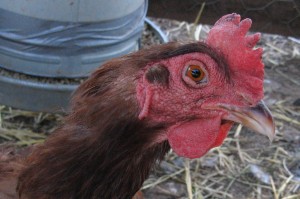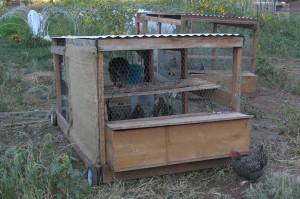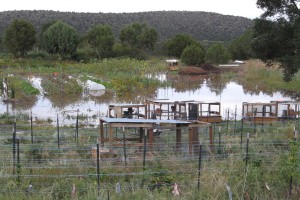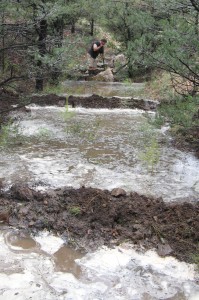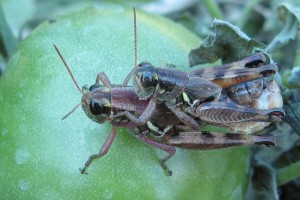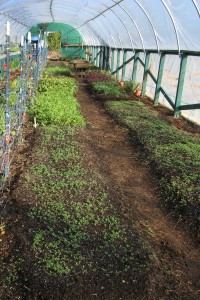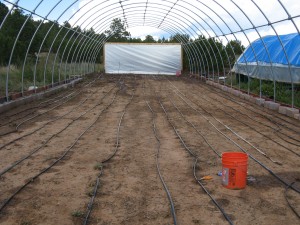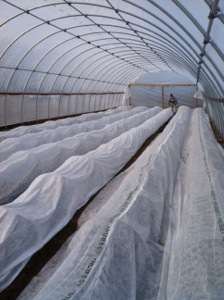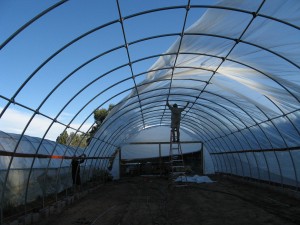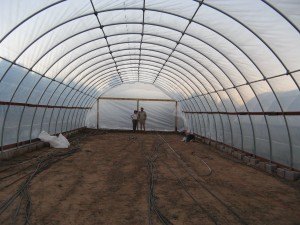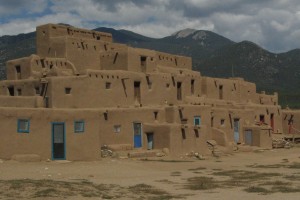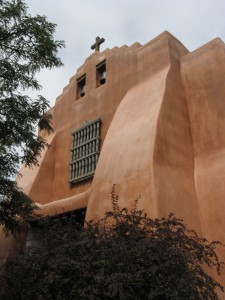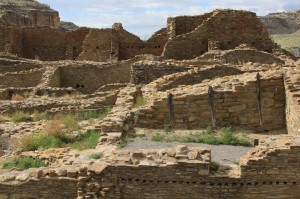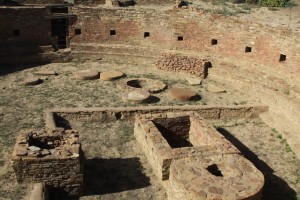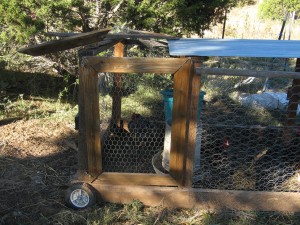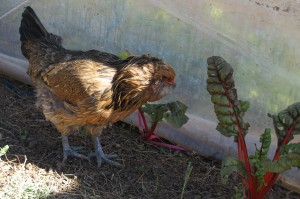My third farm was Bodhi Farms near Las Vegas, New Mexico.
The Farm
The farmers are Brian and Roxanne. They started the farm in 2008 after leaving the bustle of Southern California for the rural life and clean air of New Mexico. Both of them were tired of living in Southern California and wanted to buy some land. Brian had the idea to come to New Mexico. After buying twenty-three acres of land, they realized they needed something to grow on it to bring in money. They decided to grow petite greens. Petite greens are salad greens that are cut when the leaves are only a few inches long. The plant continues to grow and can be cut many times. Since greens are sensitive to weather, the farm has a variety of greenhouses. They had just finished building a high tunnel greenhouse (think airplane hanger size) when I left. Their goal is to be able to grow greens all year round. Greens fetch a high price in the winter. The farm also grows other vegetables like carrots and basil, and has lots of chickens that live in chicken tractors so they don’t eat the greens. Eggs sell for a good price in Santa Fe. Roxanne is experimenting with different kinds of sprouts – sunflower, corn and peas – to add to their product line. They sell at the Santa Fe and Las Vegas farmers markets. Last year a WWOOFer gave them the idea to sell to restaurants and now they have a growing list of restaurants and health food stores they sell to.
My Farm Experience
My days started around 7:30 with the tinkling of a spoon and the sound of a match lighting the kitchen stove to make coffee. That was my cue to get up. Roxanne would make a hearty breakfast and we’d head out to the farm by 9:30. “First get Spicy and then get Ovation.” One important task was to learn what the different greens looked like. Spicy is a blend of five types of mustard along with some other greens. Ovation is a milder mix. The plants grew thickly in beds in the greenhouses. To harvest the greens, I gently put my thumb and index fingers around a bunch of plants and cut above where the stem branched out and new leaves would grow. The greens were put in a bucket of cold water. Once they were all cut, they were submerged in water to get the dirt off, then picked up in a Thule made of cheesecloth type material and spun around by hand to get the water out. The greens were put in plastic bags and then placed inside an ice chest to be transported.
By three in the afternoon, the hens were done laying eggs. I went to each of the twelve tractors to collect eggs and fill water buckets and feeders. I liked the chickens. They made interesting noises. My favorites were the ‘I just laid an egg!” song and “Oh, I don’t know about that.” worried murmur.
We finished working between 5:00 and 6:00. Brian had started brewing beer so we’d pop open an IPA. Roxanne introduced me to the TV series Breaking Bad which was filmed in Albuquerque. After dinner, I watched a few episodes with her.
Just as I was starting to get comfortable with my new tasks, a storm rolled in. It rained during the night and I woke up the next morning to see Brian out by the chicken tractors standing in a pond of water. A low area of the farm was flooded. Water was flowing swiftly down the normally dry arroyo that ran along one side of their property. Brian decided to make retaining ponds by damming the arroyo in various places. As the rains continued falling hard, we moved logs, rocks and dirt to form the dams. However, it didn’t take long for the force of the water to breach the dams. We filled in the holes and continued working upstream. The idea was to slow the water down. Brian put a hole on one side of a dam and then put a hole on the opposite side of the next dam so the water had to run in a zig-zag patttern down the arroyo. It rained all week. Each day Brian returned to the arroyo to fix the dams that had failed and build new ones. The water kept rising and the greenhouses got flooded. Eventually the rain slowed and Brian got pumps to drain the pond. It took a good week for the ground to dry out.
We started to get back to normal the following week. The chickens and soil were drying out. A large restaurant order came in and we scampered to fill it. I was starting to master my cutting technique and learn the different greens. Then Brian announced that the first frost of autumn was coming. The shade cloths were removed from the greenhouses to give more warmth for the replanted beds to germinate. Brian put the doors back on the greenhouses to keep the nighttime cold out. And I frantically picked as many green tomatoes as I could to put in the well house to ripen.
My final week at Bodhi Farms had beautiful, warm weather. I wore shorts to celebrate. The project before I left was to finish the large, high tunnel greenhouse. The WWOOFers who were at the farm before I arrived helped put up the metal frame. I helped Brian put the film, the material that covers greenhouses, on the ends of the greenhouse. My task was basically to hold the ladder, hand him tools and picked up the screws he dropped. Since I’ve never done construction, I enjoyed watching the process. I learned to identify wood screws, tech screws and carriage bolts. I also held the boards that ran along the sides of the greenhouse so Brian could drill screws through the boards and into the frame. The final step in finishing the greenhouse was putting the film over the top. On the last, and much smaller, greenhouse they built, this hadn’t gone well: The film on its roll was heavy to move and once thy got it over the top, the wind picked up and blew it back off. They had learned many lessons and Brian planned accordingly. First he checked the daily weather forecast for a windless day. Even a small breeze would make a kite out of the film. Then he went to the local coffee shop to round up some helpers. They’d learned it was better to attach one side of the film with the wiggle wire before flipping it over the top, so Roxanne and Brian attached one side. The windless hour arrived along with two helpers, both men experienced with working with sails. The three men knew how to do it this time and the film went on in thirty minutes without a hitch. Brain was happy and relieved to finally have the greenhouse finished. Roxanne talked him into going out to dinner to celebrate. While Roxanne and I enjoyed our meal, Brian was so tired and sore he had to leave the table to lie down. My last two days were spent planting starter green in the new greenhouse.
On the weekends I explored New Mexico. The first weekend I went to the area around Las Vegas to visit the Light Sanctuary at the World School (the windows make colorful prisms on the walls.) in Montezuma and to soak in the hot springs. I also visited Taos. I had coffee at a shop where you choose a rock that has particular powers to put in your cup. I choose the black Apache Tears to help me see the unseen. Most of my time in Taos was spent at two breweries (green chile beer!) and at Taos Pueblo. The pueblo is on the list of UNESCO living cultural sites. The Native Americans who live there were forced away but then fought to regain their land. They are still fighting to get the surrounding land protected. They are trying to get a no-fly zone for the area. Also, they use the dominate mountain on the horizon as a calendar. They want the land between their pueblo and the mountain protected against high-rises so they can continue to see the mountain and use it in the traditional way. Many of the Native Americans sell crafts at the pueblo. They also will tell you about its history. One man showed me a photo of President Obama signing legislation giving them back their water rights.
I went to Santa Fe a few times. The city is visually unique. Most of the buildings are faux-adobe and painted brown. They are not the typical square box shape. They have rounded corners and have more creative shapes. I visited the Georgia O’Keeffe Museum and the International Folk Art Museum. The folk art museum had a display of Japanese kites along with a video showing the process of putting on one of their popular kite festivals. The Georgia O’Keeffe museum also had two videos discussing her life. I thought having videos with the exhibits brought the art to life and enhanced my appreciation of it.
The most interesting weekend was spent at Chaco Canyon National Monument. Chaco Canyon was inhabited one thousand to eight hundred years ago. Ruins of great houses, where community events and celebrations were held, and villages, where the people lived, are scattered in the canyon. Some have been fully excavated, some have been partially excavated and others are still plant-covered hills. I went on a ranger-led tour of Casa Bonita, the largest great house. I learned that the Puebloan people had traded with the Indians in what is now Mexico to get cacao, the important ingredient in chocolate. Things got more interesting after dinner as I sat in my lounge chair playing my ukulele and watching, with everyone else in the campground, a thunder and lightening storm move down the canyon towards us. When the wind swept dust down the pavement into my eyes, I got up and put everything away. I’d noticed metal rings on the wood frame of the tent pad when I set up my tent. I looked at my tent flapping in the wind and thought I should tie guy lines to the metal rings in case the wind got stronger. I tied one guy line but the one on the other side wouldn’t reach. The next thing I remember is seeing my tent upside down flapping violently in the air. The only thing keeping it from going down the canyon was the one guy line attached to the metal ring. The tent was being pulled so strongly by the wind that I was worried the guy line would rip a section out of the tent. As I was trying to control my tent, a young woman appeared next to me to help. I cut the guy line and we stuffed the tent in the back of my car. I spent the next forty-five minutes soaking wet in the car watching the lightening go by down the canyon. When the rain stopped I got back out and set up my tent. Amazingly, nothing got soaked in the car nor did my sleeping bag or pillow. The next morning was the equinox. The campground awoke at 5:00 am to drive to a large kiva to watch the sunrise. I took down my tent so it couldn’t blow away while I was gone. At the kiva we all lined up to see the sun as it rose and came through a special door. Clouds started moving towards the sun and we got nervous that we wouldn’t get to see anything. I was at the back of the line looking around and listening to people chat. After a while a woman came by and told us we needed to push the people in front of us away or we wouldn’t get to see anything since the clouds were about to obscure the sun. We stood there patiently waiting until the people in front of us got up and left. When we peered in the door we saw orange tinted clouds. I’m not sure what we would have seen if the sun had still been out. Oh well. I went off and had breakfast. I was looking forward to spending the day hiking around the canyon and visiting the ruins. As I started walking around the ruins, I noticed black storm clouds in the not too far distance. How much time would I have? Not much, it turned out. It started pouring and hailing. The road to the park is dirt and prone to being washed out. I was told it was still passable as I left. I drove through a flooded arroyo (I let someone else go first to make sure it was safe), had no problem with the hill and enjoyed the wet muddy stretch where my car got a mud bath from an on-coming car. I lost sight of the little passenger car behind me when I got beyond the muddy area. I wonder if it made it out. I may have been on a road that actually required four-wheel drive. My Subaru must have been happy. For most of the drive back to the farm storm clouds and lightening were in the distance. Occasionally, I saw cars pulled off the road and people watching the lightening. I kept looking at the patches of blue ahead of me and hoped to find clear blue skies again.
Question: Why do chickens live in tractors?
Answer: 1. They’re not good drivers.




